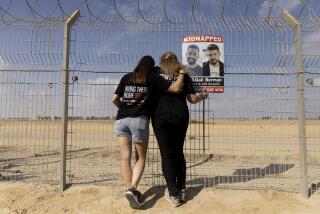This Time Out, the American Strategy Includes Victory : Battlefield: In Vietnam, tactical triumphs were squandered. In the Gulf, the equation of war is complete.
War may be simply defined as âopen armed conflict between countries,â but it is not so simply conducted.
War is not just the meshing of air, sea and land-based conflict. That is just how wars are fought. Combined, they equal just one part of the equation of war. War is actually conducted on three levels: strategic, operational and tactical.
Each dimension has its own commanders, its own goals and objectives and its own peculiar dynamics. While distinct, if victory is to be achieved, each must work in coordination and conjunction with the other levels.
âAt the end of the most grandiose plans and strategies,â reads the caption of a poster in the Armyâs War Plans Directorate in the Pentagon, âis a soldier walking point.â Portraying a World War II infantryman with rifle and fixed bayonet advancing against the enemy, it is a reminder to those staff officers mapping out future military campaigns that their strategic plans must be capable of tactical execution by soldiers on the front lines.
The Vietnam War provided a bitter corollary. No matter how well the soldiers on the front lines executed their missions (and most American servicemen and women in Vietnam did everything their country asked them to do and more), it was all for naught if the plans and strategies had not been properly drawn.
Not only were they not properly drawn, they were not drawn at all. In the wake of the enemyâs 1968 Tet offensive, it was found that the Joint Chiefs of Staff, after almost four years of war, had no concept of victory and no plans to win the war. Those strategic failures wantonly squandered, at a great price, all the tactical victories won by the Americans on the battlefield.
In the aftermath of Vietnam, the levels of war came under scrutiny. Previously, only two levels were considered--the strategic level, where political and military objectives were synchronized, and the tactical level, where the actual fighting took place. Closer examination of battlefield dynamics revealed there was a third necessary level--the operational, or theater of war level, where tactical engagements are coordinated.
For example, at the tactical level there are only three basic forms of attack--frontal attack, penetration and envelopment. But at the operational level, these may be used in conjunction with each other. One unit might be ordered to make a frontal attack, to pin the enemy down, while another launches a penetration and yet another sweeps around the enemyâs flanks in an envelopment.
How does this apply to the war in the Persian Gulf?
At the strategic level, President Bush, in his role as commander in chief, is in overall command. His principal military advisers include Defense Secretary Dick Cheney and Gen. Colin L. Powell, chairman of the Joint Chiefs of Staff.
But war at this level is a political act that has political, diplomatic, economic, sociological and psychological as well as military dimensions. Congressâ declaration of support for the use of military force was critical, and Secretary of State James A. Baker IIIâs diplomatic efforts to build and maintain the worldwide coalition against Saddam Hussein is as vital to the war effort as Cheneyâs mobilization of the armed forces.
Vital too are the efforts of the Commerce and Treasury secretaries to regulate and enforce economic sanctions that cut off the Iraqi military from outside supplies of arms, equipment and spare parts. And from a sociological standpoint, the mobilization of the American people in support of the war, as the Vietnam War proved, is absolutely essential. Psychological warfare is also an important part of the conflict, and it is in this context that Administration complaints that some in the media are aiding the enemyâs propaganda effort must be considered.
Goals and objectives at the strategic level are always political. In the present case, U.S. strategic goals have been incorporated into a series of United Nations resolutions that require Iraq to immediately and unconditionally withdraw from Kuwait, restore Kuwaitâs sovereignty, independence and territorial integrity and require the restoration of peace, security and stability in the area.
The job at the operational level is to take these political goals and translate them into achievable military objectives. Thatâs the task at hand for Gen. H. Norman Schwarzkopf, the military commander in the Gulf. Assisted by a staff that includes senior Air Force, Navy, and Marine commanders, Schwarzkopf has to reconcile the political goals not only with the military capabilities he has at his disposal, but with the political and military objectives of the other coalition members.
Before the war began, there were those who believed that without unity of command--that is, the appointment of a single commander over all allied forces--unity of effort could not be achieved. But the success of the allied air campaign, which has coordinated thousands of U.S., Saudi, British, Canadian, French, Italian, Kuwaiti, Qatari and other allied air sorties, belies that early pessimism. Not all coalition members have placed their forces directly under Schwarzkopfâs command.
Schwarzkopfâs task, in cooperation with the other allied commanders, soon will shift to coordinating the ground effort as well, keeping up the air attack while maneuvering the U.S. Armyâs VII and XVIII Corps and the land forces of the allies, in order to close in on Saddam Husseinâs army and destroy it.
Finally, there is the tactical level. Thatâs where the actual fighting occurs. Combat aircraft of the Air Force, Navy, Marines and Army already are engaged in the tactical battle, as are some warships in the Persian Gulf and some Army and Marine elements along the Saudi-Kuwaiti border. But the bulk of Army and Marine infantry, armor, cavalry and artillery battalions are still waiting in the wings.
Here, Air Force, Navy and Marine air wing and squadron commanders, and the Army and Marine division, brigade and regimental commanders, are running the show. Their objectives will include creating gaps in enemy lines, seizing enemy strongpoints and fortifications and the like.
There is nothing new in these tactical objectives. What is new, as compared with Vietnam, is that the military is determined that fighting at the tactical level will be directly connected to the achievement of theater of war operational objectives.
These objectives, in turn, will be focused on the attainment of the political goals of the United States. This time, if the military can help it, the bravery and sacrifices of that âsoldier walking pointâ will not be frittered away.
More to Read
Sign up for Essential California
The most important California stories and recommendations in your inbox every morning.
You may occasionally receive promotional content from the Los Angeles Times.










